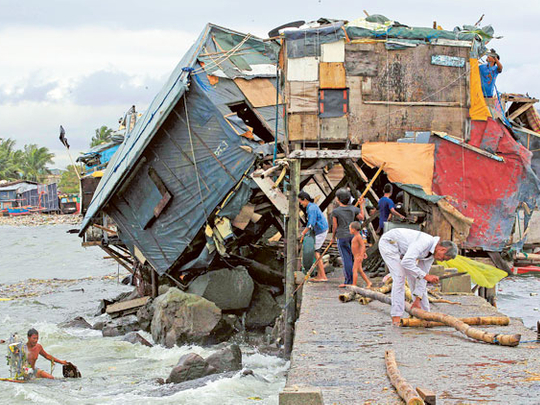
Manila: Forty people three were killed, including five missing, 15 more were hurt, one million residents were affected, 530,000 remained at evacuation centres, and a large part of Metro Manila, northern and southern Luzon, including affected areas in central Philippines continued to suffer from power outages on Thursday, a day after Typhoon Rammasun (locally known as Glenda) left for the South China Sea on Wednesday night. Its wind of 250 kilometre per hour left a wide chaotic landscape of uprooted trees, damaged agricultural products, houses, infrastructure, sources of power, including billboard frameworks in all affected areas from Tuesday to Wednesday, officials and sources told Gulf News.
“Everything will return to normal, more or less, on Friday, as far as supply of electricity is concerned, ” Meralco senior vice president Alfredo Panlilio told Gulf News. He did not explain the extent of the typhoon’s damage on sources of power supply.
Not everyone was happy with Panlilio’s promise. Metro Manila slowly inched to normalcy with 35 per cent of 12 million residents without electricity on Thursday, a slow change from 84 per cent which suffered power outage at the height of the storm on Wednesday.
Metro Manila’s northern suburban Bulacan fared better with 11 percent without electricity. In southern Luzon, 99 percent of Quezon province remained without power, 94 percent of Batangas remained without electricity, 67 and 61 percent of Cavite and Laguna, respectively, also suffered from power outtages.
“I was shocked to see rows of uprooted 60-year old acacia trees at the grounds of De La Salle University (in Metro Manila’s southern suburban Cavite),” Benjamin Gabriertan, a resident of Cavite which was hard-hit by Typhoon Rammasun told Gulf News.
Trees fell on cars that were parked on the road of Cavite, Gabiertan said, adding that he found similar scenes in other areas of Cavite.
“My rooftop was damaged at past midnight of Wednesday by swirlings wind that circled on my rooftop,” narrated Gabiertan, adding that he stopped his son Bobot from going up to the rooftop for fear that he might be taken away by the wind.
Cleaners who belong to Public Works and Highways worked hard on Thursday to clean streets of debris of uprooted trees, signages, and other remains of the typhoon’s wrath.
A big tree also fell on a toll gate in Southern Luzon Expressway, prompting buses and vehicles to take alternate routes, prompting authorities to close the major expressway on Wednesday, a motorist said.
“The fallen tree is being taken away now. Hopefully, the Southern Luzon Expressway will be opened to motorist 100 percent,” said one of the workers who were contracted by the department of public works and highways for a massive clean-up operation in Cavite.
Residents on coastal areas of Cavite attested that waves rose up to five metres which affected the Cavite Lex (road). “I heard that three to four- metre high waves also undulated on Manila Bay which flooded Manila’s Roxas Boulevard on Wednesday,” said a sidewalk vendor in Cavite’s coastal road.
Some 5,000 who were stranded in all affected areas started to move after authorities allowed airplanes, passenger ferries, and busses to continue operating. But in all affected areas, many roads and bridges were still impassable. Some 152 domestic and international flights were canceled, and the Philippine Coast Guard did not allow passenger ferries to sail from Tuesday to Wednesday.
The typhoon’s first fatality, Lourdes Ongray Lim, 25, died on the spot when an electric post fell on her in Allen, Northern Samar on Tuesday. Four more were killed, three of them in Lucena City, Quezon Province, and one in central Luzon, as Typhoon Rammasun’s path widened across the country, from east to west, south to north, from Tuesday to Wednesday, an official of the National Disaster Risk Reduction and Management Council (NDRRMC) told Gulf News.
Antonio Habana, 16, and Jesus Vargas, 84, were injured when they stepped on lose live wire in Nato village in Sagñay, Camarines Sur, southern Luzon on Tuesday, said the official, adding that more people died from fallen trees and flying debris than from drowning, electrocution, or mudslides because Typhoon Rammasun carried “more wind and fury than water”.
Eleven roads and one bridge were not passable in hard-hit Samar, central Philippines. “They were either wrecked or layered with typhoon debris on Tuesday. All other areas were Typhoon Rammasun rudely passed suffered the same destruction,” NDRRMC said.
“It was a good thing that people didn’t die from drowning,” said Governor Joey Salceda of Albay, southern Luzon. “But many residents were sleepless and terrified when they heard the roar of Typhoon Rammasun,” Salceda added.
Dozens of fishermen who did not heed the early warning of local government officials from Philippines east and western seaboards on Tuesday remained missing on Thursday,
Tarpaulin sheets on billboards were rolled but several steel frames in Metro areas were damaged by Typhoon Rammasun.
Schools, private and public offices, malls, shopping centres, wet markets, and restaurants opened in Metro Manila. At the height of the storm, from six to 12 in the morning of Wednesday, the whole of Metro Manila looked like an eerie ghost town as 94 percent of its 12 million residents stayed indoors.
Banks started operating, but many ATM machines remained “offline” on THursday.











